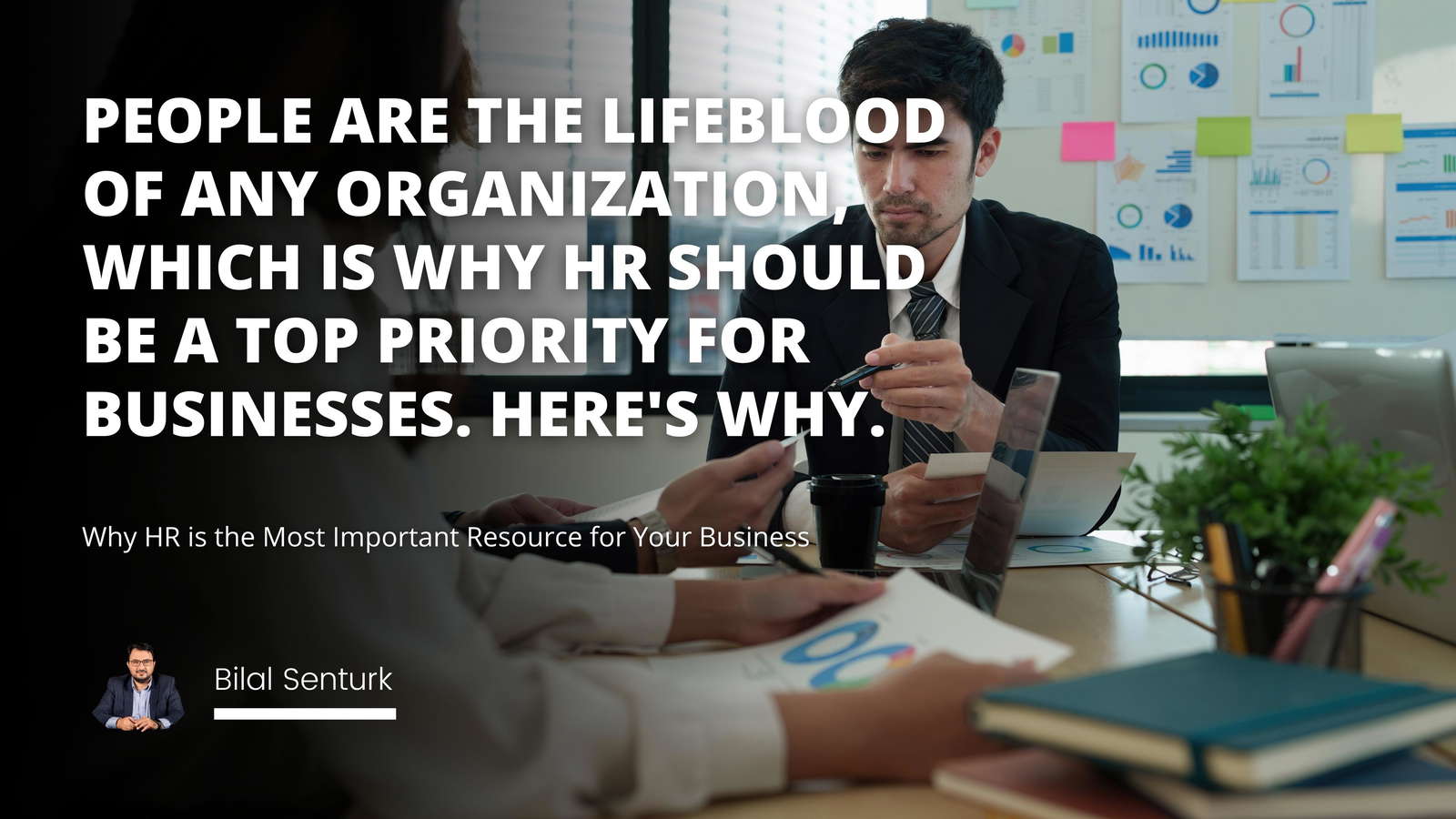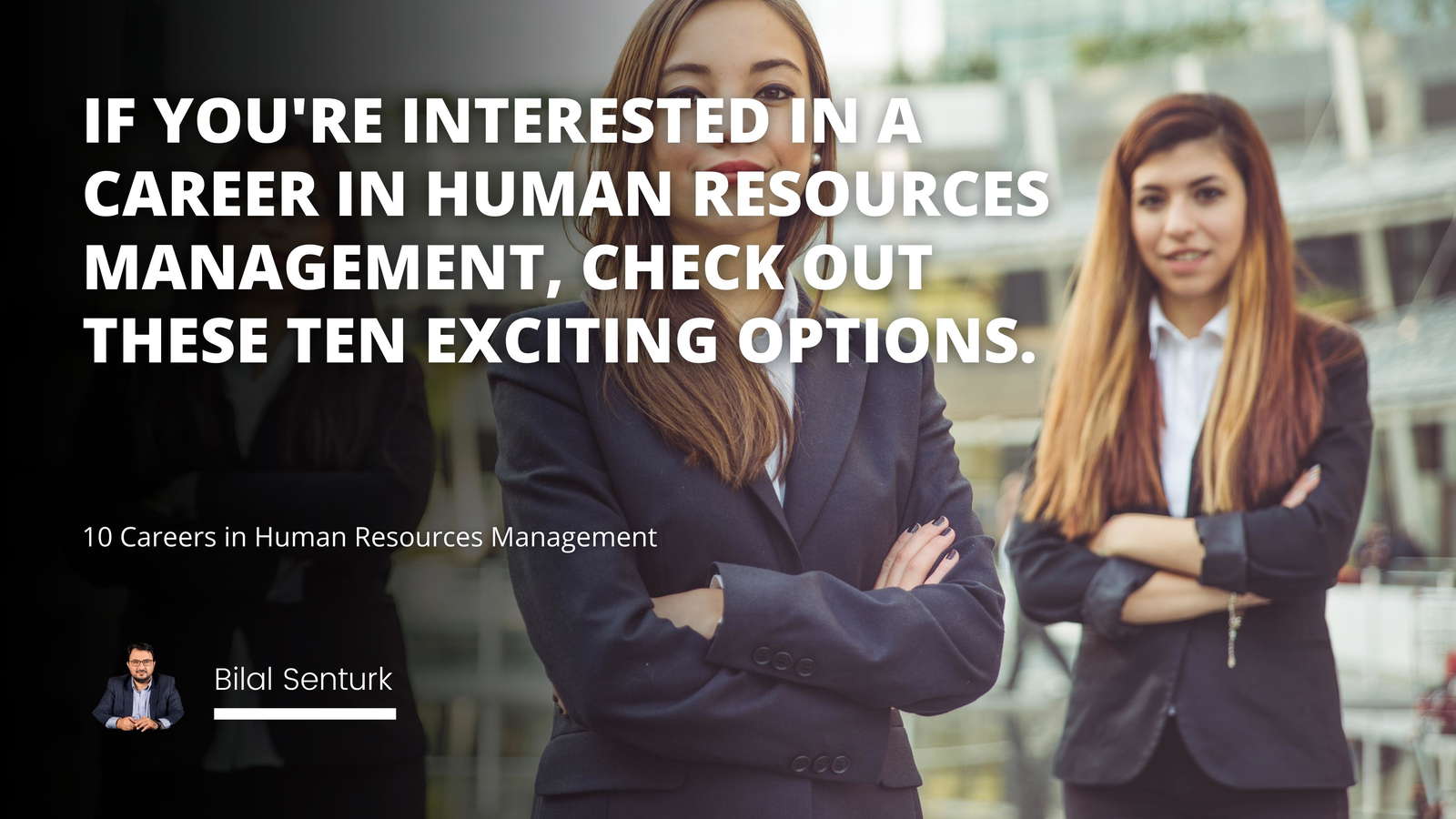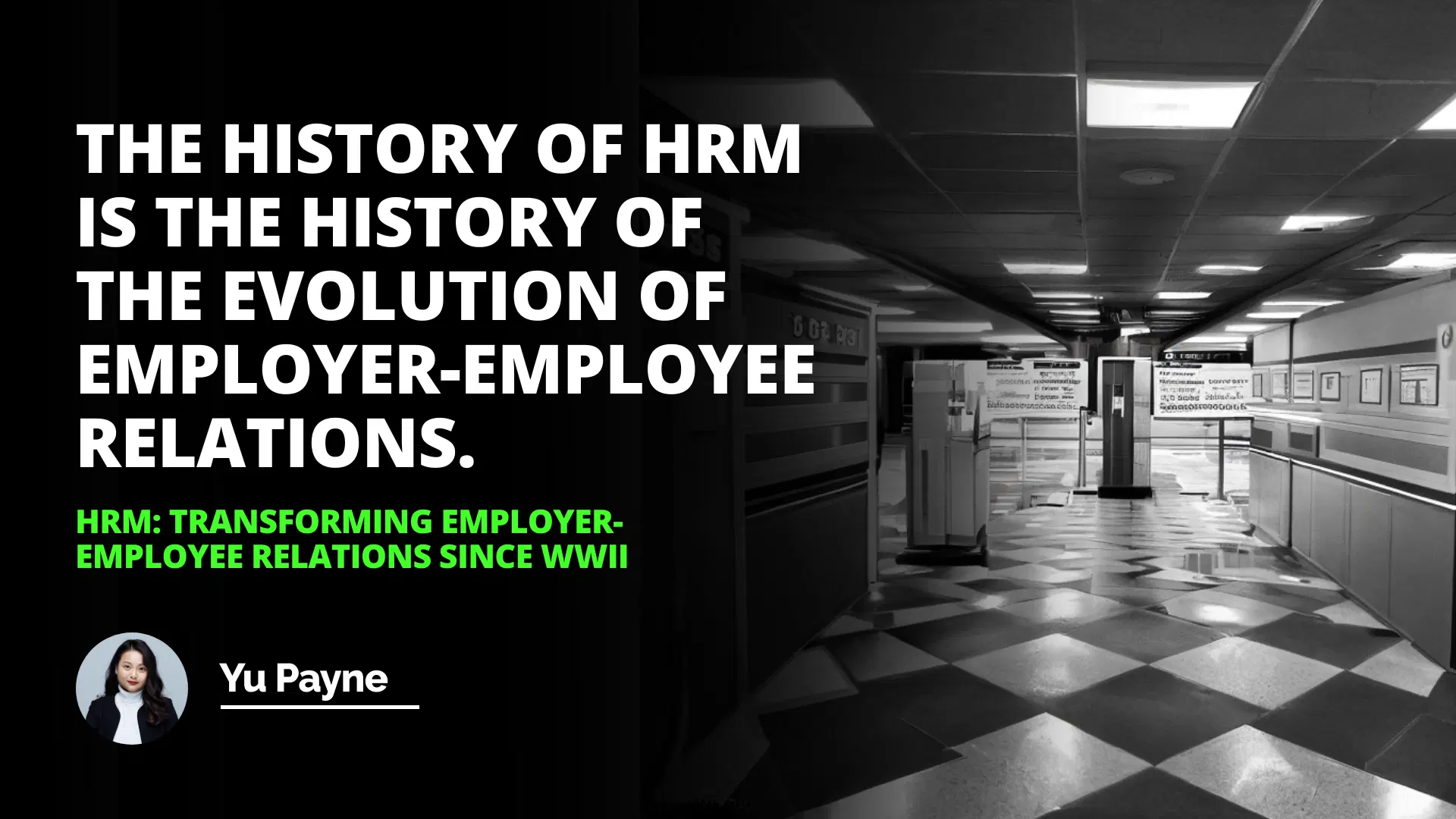
The growth of the personnel function after WWII was a pivotal period in the history of human resource management. The rapid industrialization and technological advancements that followed the war created an unprecedented demand for skilled workers, particularly in technical and engineering fields. As a result, personnel departments found themselves scrambling to expand their recruitment efforts and develop more sophisticated wage and salary programs to attract and retain top talent.
I remember my grandfather telling me stories about his experience working in a factory in the 1950s. He would often reminisce about the changes in HR practices post-WWII, marveling at how quickly things had evolved. "Back then, the personnel department was just a small office in the corner of the building," he would say with a chuckle. "But by the time I retired, it had grown into a full-fledged department with its own floor and a team of professionals."
Introduction
Growth of the Personnel Function after WWII
The shift in Power Between Managers and Personnel
Employment Legislation of the 1960s and 1970s
Conclusion
The shift in power between managers and personnel was another significant development during this period. As workers began to organize and assert their collective voice, management could no longer exercise unilateral control over the workplace. This shift was further reinforced by the evolution of HR management since WWII, which saw the emergence of formalized employer-employee relations programs and a greater emphasis on employee rights and well-being.
The impact of employment legislation in the 1960s cannot be overstated. Laws such as the Equal Pay Act, the Age Discrimination in Employment Act, and the Occupational Safety and Health Act established a legal framework for protecting workers' rights and ensuring their safety on the job. These laws also had a profound impact on the role of technology in shaping HR practices, as personnel departments had to adapt to new record-keeping and compliance requirements.
The significance of the personnel function in organizations became increasingly apparent during this period. As Peter Drucker observed in his seminal work, The Practice of Management, "The personnel function is not a necessary evil; it is an essential part of the business enterprise" (Drucker, 1954, p. 243). Drucker's insights were echoed by other management theorists of the time, such as Douglas McGregor, whose The Human Side of Enterprise emphasized the importance of understanding and motivating employees (McGregor, 1960).
Bridging The Gap Between Workplace İlliteracy And Success Strategies
Long Tail Keyword: Hr Vendor Management Strategies For Optimal Efficiency
The history of employment legislation in the 1960s and 1970s is a fascinating study in the evolution of workers' rights. From the Civil Rights Act of 1964, which prohibited discrimination based on race, color, religion, sex, or national origin, to the Employee Retirement Income Security Act of 1974, which established minimum standards for pension plans, these laws fundamentally reshaped the American workplace (Kochan, Katz, & McKersie, 1986).
The importance of employee rights and safety in HR cannot be overstated. As Maslow's hierarchy of needs suggests, workers cannot be expected to perform at their best if their basic needs for safety and security are not met (Maslow, 1943). This insight has been borne out by numerous studies over the years, including a recent meta-analysis by Christian, Bradley, Wallace, and Burke (2009), which found that workplace safety is positively associated with job satisfaction, organizational commitment, and job performance.
The history of HRM is the history of the evolution of employer-employee relations.

The professionalization of the personnel function in modern workplaces is a testament to the enduring legacy of the post-WWII era. Today's HR professionals are highly trained and specialized, with a deep understanding of employment law, organizational psychology, and business strategy. As Ulrich and Brockbank (2005) argue in their book, The HR Value Proposition, HR professionals must be able to create value for their organizations by aligning HR practices with business objectives and delivering measurable results.
Looking to the future, it is clear that the personnel function will continue to evolve and adapt to new challenges and opportunities. One area of particular interest is the role of technology in shaping HR practices. From artificial intelligence and machine learning to virtual reality and gamification, new technologies are transforming the way HR professionals recruit, train, and engage employees (Stone, Deadrick, Lukaszewski, & Johnson, 2015).
Another key trend is the growing emphasis on diversity, equity, and inclusion (DEI) in the workplace. As organizations become increasingly global and multicultural, HR professionals must be able to create inclusive environments that value and leverage diversity (Shore et al., 2011). This requires a deep understanding of cultural differences, as well as a commitment to ongoing learning and development.
Ultimately, the success of any organization depends on its ability to attract, retain, and engage top talent. As the personnel function continues to evolve and mature, it will play an increasingly critical role in helping organizations achieve this goal. By staying attuned to the latest trends and best practices in HR, and by always putting the needs of employees first, HR professionals can help create workplaces that are not only productive and profitable, but also fulfilling and meaningful for all who work there.
References
Christian, M. S., Bradley, J. C., Wallace, J. C., & Burke, M. J. (2009). Workplace safety: A meta-analysis of the roles of person and situation factors. Journal of Applied Psychology, 94(5), 1103-1127.
Drucker, P. F. (1954). The practice of management. New York, NY: Harper & Row.
Kochan, T. A., Katz, H. C., & McKersie, R. B. (1986). The transformation of American industrial relations. New York, NY: Basic Books.
Maslow, A. H. (1943). A theory of human motivation. Psychological Review, 50(4), 370-396.
McGregor, D. (1960). The human side of enterprise. New York, NY: McGraw-Hill.
Shore, L. M., Randel, A. E., Chung, B. G., Dean, M. A., Holcombe Ehrhart, K., & Singh, G. (2011). Inclusion and diversity in work groups: A review and model for future research. Journal of Management, 37(4), 1262-1289.
Stone, D. L., Deadrick, D. L., Lukaszewski, K. M., & Johnson, R. (2015). The influence of technology on the future of human resource management. Human Resource Management Review, 25(2), 216-231.
Ulrich, D., & Brockbank, W. (2005). The HR value proposition. Boston, MA: Harvard Business School Press.
Frequently Asked Questions
How has the personnel function changed since WWII?
Since the conclusion of WWII, the personnel function has undergone numerous changes that have had a dramatic impact on the way organizations recruit, develop and manage their employees.
One of the most significant changes to the personnel function since WWII has been the shift from a transactional administrative role to one that includes more strategic responsibilities.
Organizations have begun to recognize the importance of personnel in developing their competitive advantage and are increasingly relying on the personnel function to develop and implement strategies to maximize the contribution of their employees. This shift has been driven by an increased focus on human capital, with organizations recognizing the need to recruit and develop the most talented employees to remain competitive.
In addition to the shift to a more strategic role, the personnel function has also seen a change in focus from short-term to long-term objectives. Organizations are increasingly focusing on developing and maintaining a high-quality workforce over the long term to maximize the value of their human capital assets. This is achieved through the implementation of targeted recruitment and development strategies, and by paying greater attention to employee engagement, retention, and motivation.
Another significant change since WWII has been the increased emphasis on diversity and inclusion. Organizations have become increasingly aware of the need to ensure a diverse and inclusive workforce to remain competitive, and the personnel function plays an essential role in developing and implementing diversity and inclusion strategies.
Finally, the personnel function has recently seen an increased focus on technology. Organizations are increasingly leveraging technology to streamline the recruitment and development process and monitor and evaluate employee performance. This shift has allowed organizations to increase efficiency while also better targeting their recruitment and development efforts.
In conclusion, the personnel function has undergone numerous changes since WWII, and these changes have dramatically impacted how organizations recruit, develop and manage their employees. Organizations are increasingly relying on the personnel function to develop and implement strategies to maximize their employees' contribution and ensure a diverse and inclusive workforce. Additionally, the increased focus on technology has allowed organizations to increase efficiency and better target their recruitment and development efforts.
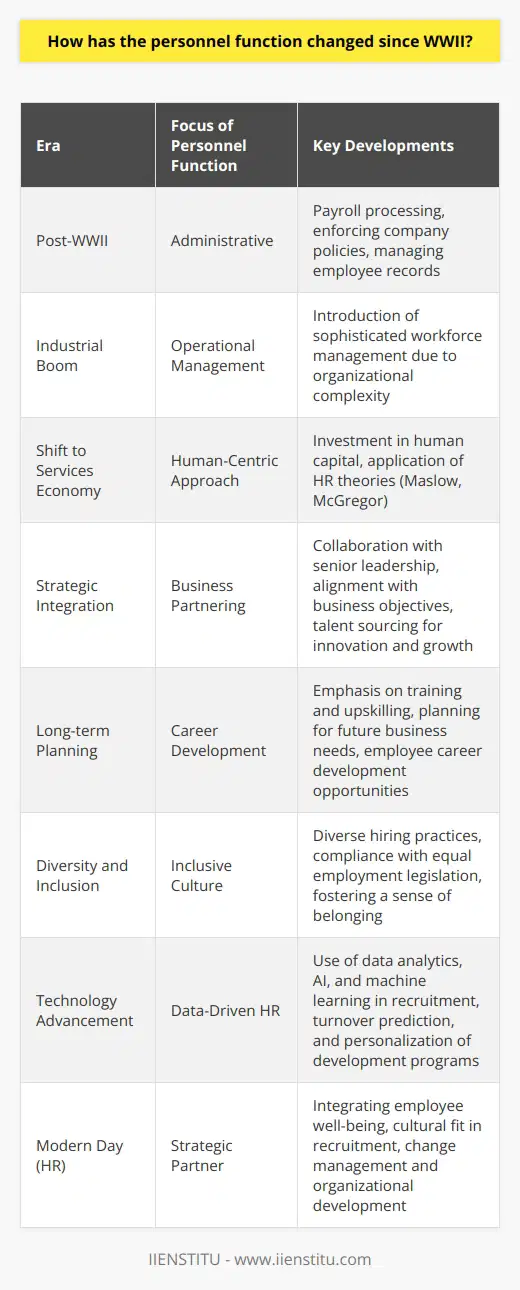
What impact did employment legislation of the 1960s and 1970s have on HRM?
The employment legislation of the 1960s and 1970s significantly impacted Human Resource Management (HRM). This period saw the introduction of a range of laws and regulations that sought to protect workers’ rights and ensure their safety in the workplace. In particular, the Equal Pay Act of 1963 and the Occupational Safety and Health Act of 1970 have had lasting influence on HRM.
The Equal Pay Act of 1963 made it illegal to pay different wages to men and women performing the same job. This significantly impacted HRM in terms of how employers approached hiring and paid policies. It forced employers to be more conscious of the gender pay gap and to ensure that they paid employees the same amount regardless of gender. This has had a lasting impact on HRM, as employers now have to be mindful of pay disparities and take steps to ensure that their hiring and pay policies are fair and equitable.
The Occupational Safety and Health Act of 1970 was another primary legislation impacting HRM. This law set out several requirements that employers had to meet to ensure their employees' safety. This included providing adequate training, ensuring proper ventilation and lighting, and using protective equipment. This legislation significantly impacted HRM, as employers had to ensure they were meeting the requirements set out in the Act to protect their employees.
Overall, the employment legislation of the 1960s and 1970s profoundly impacted HRM. It forced employers to be more conscious of worker rights and to ensure that they were meeting the requirements of the law to protect their employees. This has had a lasting impact on HRM, as employers now have to be mindful of pay disparities and take steps to ensure that their hiring and pay policies are fair and equitable.
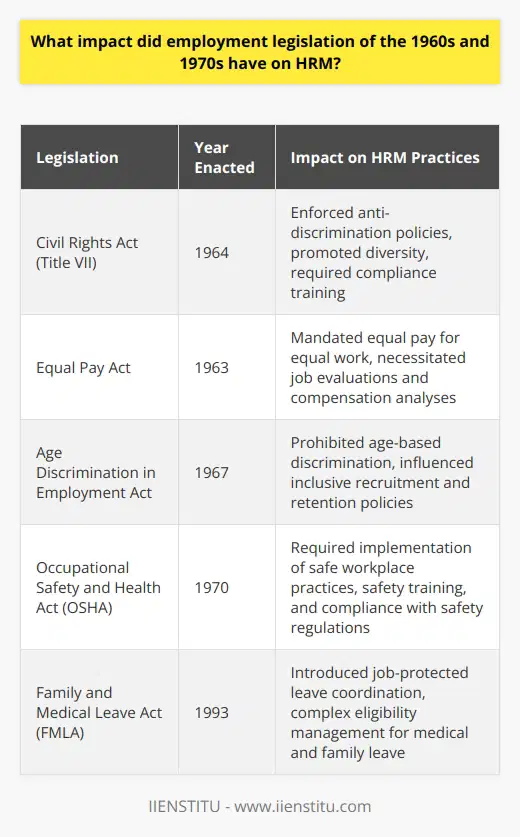
How has the power dynamic between managers and personnel shifted since WWII?
Since WWII ended, the power dynamic between managers and personnel have shifted considerably. Before WWII, managers held strong hierarchical authority over personnel and were often regarded as authoritarian figures. This power dynamic was based on the traditional view of management that gave managers the role of providing instructions and orders to personnel.
Today, the power dynamic between managers and personnel have shifted to a more collaborative approach. This shift is mainly due to the introduction of new management principles such as human relations theory and organizational behavior. These principles have fostered an environment where managers are encouraged to dialogue with personnel and collaborate on decision-making. This shift has allowed for an increase in employee engagement and a stronger sense of shared responsibility.
Furthermore, the introduction of technology has also impacted the managerial-personnel power dynamic. Technology has enabled managers to make more informed decisions, which has resulted in tremendous respect from personnel. For example, managers can now utilize data analytics to gain insight into employee performance and make more informed decisions tailored to individual needs.
Finally, the development of global markets has significantly impacted the power dynamic between managers and personnel. As organizations become more international, managers must be able to effectively manage personnel from different cultures, backgrounds, and countries. This has resulted in a shift in the power dynamic towards a more culturally inclusive approach that recognizes the unique skills and perspectives of personnel.
The power dynamic between managers and personnel have shifted significantly since WWII. This shift has been driven by the introduction of new management principles, an increase in technology, and the development of global markets. These changes have resulted in a more collaborative approach to management which has allowed for increased employee engagement, informed decision-making, and greater cultural inclusion.
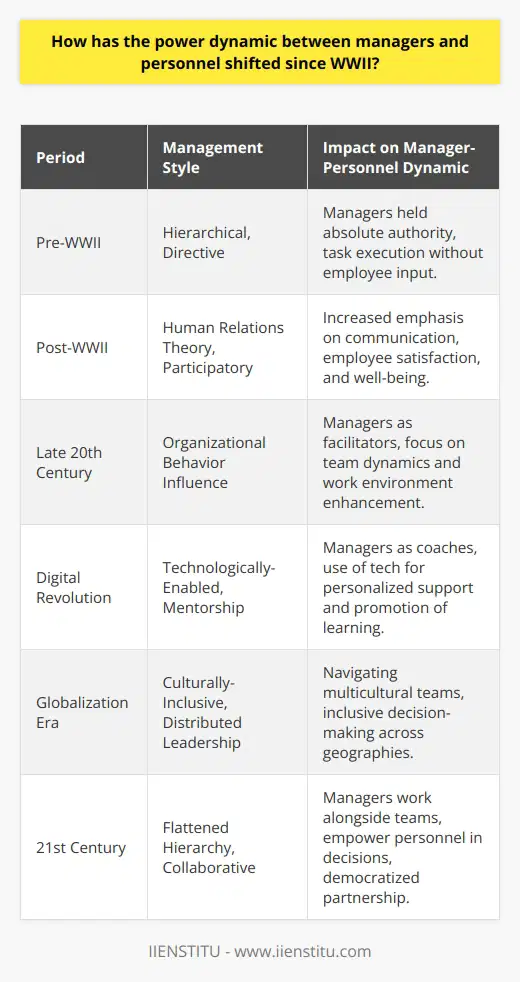
What are the 4 pillars of employee relations?
Understanding Employee Relations
Employee relations refer to efforts aimed at maintaining a positive employer-employee relationship. To establish a healthy employee relations framework, consider four crucial pillars.
Communication
Effective communication is paramount in fostering a conducive working environment. It involves sharing goals, expectations, and feedback, encouraging open and honest dialogue between employees and management.
Recognition
Appreciating employees boosts morale and engenders loyalty. Recognition could be in the form of rewards, benefits, or simple verbal acknowledgement of good work done.
Development Opportunities
Providing opportunities for growth and development is a vital aspect of employee relations. Development could include training, mentoring, or offering new roles and responsibilities to staff.
Equitable Treatment
Fairness in all aspects, from recruitment to remuneration, fosters mutual trust and respect. Equitable treatment also pertains to diversity and inclusivity within the workplace.
In conclusion, the pillars of employee relations revolve around open communication, appreciation, providing growth opportunities, and treating everyone fairly. While each pillar is essential, their true strength lies in the synergy created when all four are implemented. Therefore, a strong employee relations strategy represents a balancing act requiring ongoing effort and commitment from both sides to sustain.
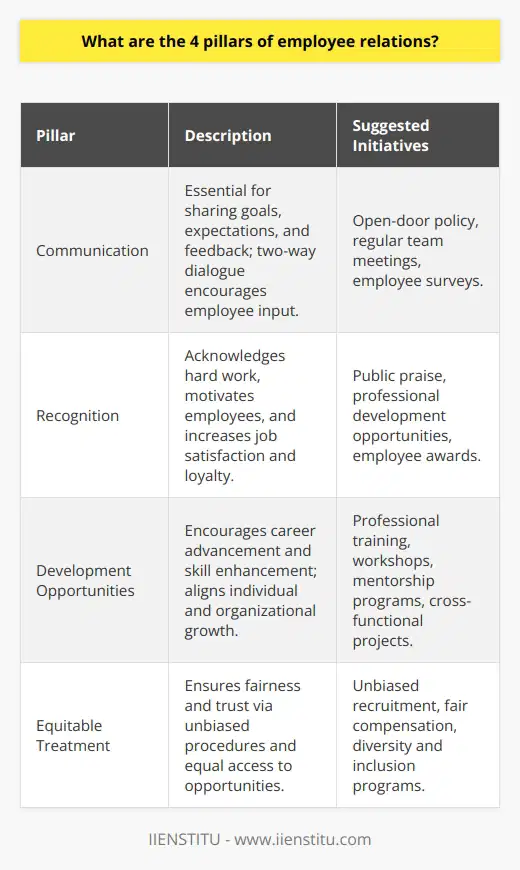
What is the relationship between HRM and industrial relations?
Relationship Blueprint
HRM, Human Resource Management, and Industrial Relations share an interdependent relationship.
Understanding HRM
Human Resource Management serves as the governing body in an organization. It refers to the strategic approach employers use to manage people who work for the company.
Involvement of HRM in Industrial Relations
HRM plays a vital role in Industrial Relations. The department works to establish and maintain a peaceful work atmosphere within an organization. This is accomplished by securing a sense of social justice for the workforce.
Understanding Industrial Relations
Industrial relations constitute the relationship between employers, employees, and the government. It is a multidisciplinary field that draws from various sectors like economics, sociology, psychology, and law.
Influence of Industrial Relations on HRM
The practices and trends in Industrial Relations greatly impact the policies and strategies of HRM. They dictate many aspects of employee management, like wages, working conditions, conflict resolution, employee welfare, and collective bargaining.
Connecting HRM to Industrial Relations
HRM integrates the employees' welfare within the organizational strategies, while Industrial Relations aim for workers' satisfaction and justice. The interplay between the two fosters a harmonious industrial environment. The link between HRM and Industrial Relations is therefore significant and influences the company's productivity and employee satisfaction.
Consequently, the intersection of HRM and Industrial Relations depicts the balancing act between employee welfare and organizational goals. An adept execution of this balance leads to enhanced productivity, employee contentment, and overall company success. The relationship between HRM and Industrial Relations is therefore essential for the efficient functioning of any organization.
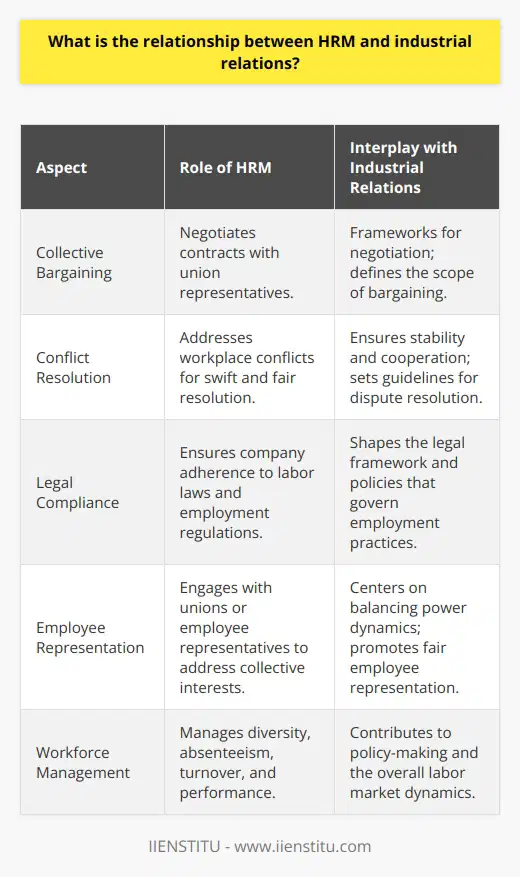
What does human resources do in employee relations?
Role of Human Resources in Employee Relations
Human resources facilitate interactions between employees and management. It implies fostering a positive work environment. HR not only addresses grievances, but also minimizes workplace conflicts.
Function as Mediator
HR acts as an unbiased mediator during conflicts. They help resolve disagreements and maintain the working relationship. This function allows employees to express dissatisfaction without fear.
Training and Development
HR also provides training and development opportunities for employees. These platforms help employees improve their skills and productivity. Furthermore, it can motivate employees leading to better performance.
Handling Disciplinary Issues
Disciplining employees is another responsibility of HR. They ensure adherence to the organization's policies. In doing so, HR protects both employees and the organization from potential harm.
Promoting Fairness and Equality
HR promotes equality by implementing inclusive policies. They create a fair and transparent work culture. It promotes a sense of belonging among employees.
Policy Implementation
HR plays a crucial role in the implementation of organizational policies. It ensures employees understand and comply with these policies. It helps maintain order in the workplace.
Employee Benefits
HR processes and manages employee benefits. They handle leaves, insurance, and retirement benefits. This service positively impacts employee job satisfaction.
Communication Channel
HR acts as a communication channel between employees and management. They facilitate open and honest discourse. This clarity can reduce misunderstandings and enhance employee engagement.
In summary, Human Resources play a pivotal role in employee relations, ensuring a harmonious and efficient work environment. Their role supports both the employee’s and the organization's overall development and progress.

